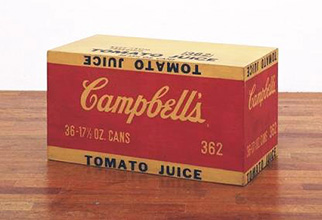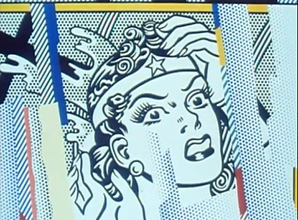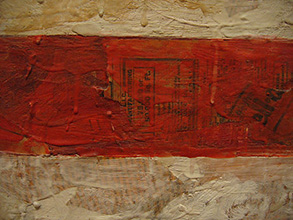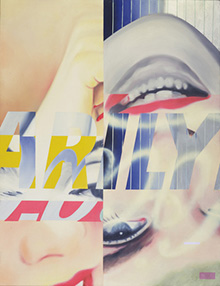Image Source: MoMA & Wikipedia
Pop Art is an art movement in 1950s-1970s in Britain and the United States. Pop art presented a challenge to traditions of fine art by including imagery from popular culture such as advertising, news, etc. In pop art, material is sometimes visually removed from its known context, isolated, and/or combined with unrelated material. The concept of pop art refers not as much to the art itself as to the attitudes that led to it.
Pop art employs aspects of mass culture, such as advertising, comic books and mundane cultural objects. It is widely interpreted as a reaction to the then-dominant ideas of abstract expressionism, as well as an expansion upon them. And due to its utilization of found objects and images it is similar to Dada. Pop art is aimed to employ images of popular as opposed to elitist culture in art, emphasizing the banal or kitschy elements of any given culture, most often through the use of irony. It is also associated with the artists’ use of mechanical means of reproduction or rendering techniques.
Pop art and minimalism are considered to be art movements that precede postmodern art, or are some of the earliest examples of Post-modern Art themselves.
Pop art often takes as its imagery that which is currently in use in advertising. Product labeling and logos figure prominently in the imagery chosen by pop artists, like in the Campbell’s Soup Cans labels, by Andy Warhol. Even the labeling on the shipping box containing retail items has been used as subject matter in pop art, for example in Warhol’s Campbell’s Tomato Juice Box 1964, or his Brillo Soap Box sculptures.
The origins of pop art in North America and Great Britain developed differently. In the United States, it marked a return to hard-edged composition and representational art as a response by artists using impersonal, mundane reality, irony and parody to defuse the personal symbolism and “painterly looseness” of Abstract Expressionism. By contrast, the origin in post-War Britain, while employing irony and parody, was more academic with a focus on the dynamic and paradoxical imagery of American popular culture as powerful, manipulative symbolic devices that were affecting whole patterns of life, while improving prosperity of a society. Early pop art in Britain was a matter of ideas fueled by American popular culture viewed from afar, while the American artists were inspired by the experience of living within that culture. Similarly, pop art was both an extension and a repudiation of Dadaism. While pop art and Dadaism explored some of the same subjects, pop art replaced the destructive, satirical, and anarchic impulses of the Dada movement with detached affirmation of the artifacts of mass culture. Among those artists seen by some as producing work leading up to Pop art are Pablo Picasso, Marcel Duchamp, Kurt Schwitters, and Man Ray.
Although Pop Art began in the late 1950s, Pop Art in America was given its greatest impetus during the 1960s. The term “Pop Art” was officially introduced in December 1962; the Occasion was a “Symposium on Pop Art” organized by the Museum of Modern Art. By this time, American advertising had adopted many elements and inflections of modern art and functioned at a very sophisticated level. Consequently, American artists had to search deeper for dramatic styles that would distance art from the well-designed and clever commercial materials. As the British viewed American popular culture imagery from a somewhat removed perspective, their views were often instilled with romantic, sentimental and humorous overtones. By contrast, American artists being bombarded daily with the diversity of mass-produced imagery, produced work that was generally more bold and aggressive.
Key Figures of Pop Art:

Andy Warhol (1928–1987) was an American artist who was a leading figure in the visual art movement known as pop art. After graduating from high school, his intentions were to study art education at the University of Pittsburgh in the hope of becoming an art teacher, but his plans changed and he enrolled in the Carnegie Institute of Technology in Pittsburgh, where he studied commercial art. In 1949, he moved to New York City and began a career in magazine illustration and advertising. In 1949, he earned a Bachelor of Fine Arts in pictorial design.
He began exhibiting his work during the 1950s. He held exhibitions at the Hugo Gallery, and the Bodley Gallery in New York City and in California his first West Coast gallery exhibition was on July 9, 1962, in the Ferus Gallery of Los Angeles. The exhibition marked his West Coast debut of pop art. Andy Warhol’s first New York solo pop art exhibition was hosted at Eleanor Ward’s Stable Gallery November 6–24, 1962. Andy Warhol was a very successful commercial illustrator. During the 1960s, Warhol began to make paintings of iconic American objects such as dollar bills, mushroom clouds, electric chairs, Campbell’s Soup Cans, Coca-Cola bottles, celebrities such as Marilyn Monroe, Elvis Presley, Marlon Brando, Troy Donahue, Muhammad Ali, and Elizabeth Taylor, as well as newspaper headlines or photographs of police dogs attacking civil rights protesters.
His works explore the relationship between artistic expression, celebrity culture and advertisement that flourished by the 1960s. After a successful career as a commercial illustrator, Warhol became a renowned and sometimes controversial artist. The Andy Warhol Museum in his native city, Pittsburgh, Pennsylvania, holds an extensive permanent collection of art and archives. It is the largest museum in the United States dedicated to a single artist.
Warhol’s art encompassed many forms of media, including hand drawing, painting, printmaking, photography, silk screening, sculpture, film, and music. He was also a pioneer in computer-generated art using Amiga computers that were introduced in 1984, two years before his death. He founded Interview Magazine and was the author of numerous books, including The Philosophy of Andy Warhol and Popism: The Warhol Sixties.
Warhol died in New York City on February 22, 1987, and was buried next to his mother and father. A memorial service was held in Manhattan for Warhol on April 1, 1987, at St. Patrick’s Cathedral, New York.

Roy Lichtenstein (1923–1997) was an American pop artist. During the 1960s, along with Andy Warhol, Jasper Johns, and James Rosenquist among others, he became a leading figure in the new art movement. His work defined the basic premise of pop art through parody. Favoring the comic strip as his main inspiration, Lichtenstein produced hard-edged, precise compositions that documented while it parodied often in a tongue-in-cheek humorous manner. His work was heavily influenced by both popular advertising and the comic book style. He described pop art as “not ‘American’ painting but actually industrial painting”. His paintings were exhibited at the Leo Castelli Gallery in New York City.
Whaam! and Drowning Girl are generally regarded as Lichtenstein’s most famous works, with Oh, Jeff…I Love You, Too…But… arguably third. Woman with Flowered Hat has held the record for highest Lichtenstein auction price since May 15, 2013.

Jasper Johns is an American contemporary artist who works primarily in painting and printmaking. Born in Augusta, Georgia, Jasper Johns spent his early life in Allendale and Columbia, South Carolina. Johns studied a total of three semesters at the University of South Carolina, from 1947 to 1948. He then moved to New York City and studied briefly at the Parsons School of Design in 1949. In 1952 and 1953 he was stationed in Sendai, Japan during the Korean War.
In 1954, after returning to New York, Johns met Robert Rauschenberg and they became long-term lovers. In 1963, Johns founded Foundation for Contemporary Performance Arts, now known as Foundation for Contemporary Arts in New York City.
Johns was elected a Fellow of the American Academy of Arts and Sciences in 1984. In 1990, he was awarded the National Medal of Arts. On February 15, 2011 he received the Presidential Medal of Freedom from President Barack Obama, becoming the first painter or sculptor to receive a Presidential Medal of Freedom since Alexander Calder in 1977. In 1990 he was elected into the National Academy of Design as an Associate member and became a full Academician in 1994.
His text Statement (1959) has been published in Theories and Documents of Contemporary Art: A Sourcebook of Artists’ Writings.

Eduardo Paolozzi (1924–2005) was a Scottish sculptor and pop artist. He investigated how we can fit into the modern world to resemble our fragmented civilization through imagination and fantasy. By the dramatic juxtaposition of ideas in his work, he lets us see the confusion as well as the inspiration.
Paolozzi studied at the Edinburgh College of Art in 1943, briefly at Saint Martin’s School of Art in 1944, and then at the Slade School of Fine Art at University College London from 1944 to 1947 , after which he worked in Paris, France. While in Paris from 1947–1949, Paolozzi became acquainted with Alberto Giacometti, Jean Arp, Constantin Brâncuși, Georges Braque and Fernand Léger. This period became an important influence for his later work. For example, the influence of Giacometti and many of the original Surrealists he met in Paris can be felt in the group of lost-wax sculptures made by Paolozzi in the mid-1950s. Their surfaces studded with found objects and machine parts, were to gain him a big recognition.
After Paris, he moved back to London eventually establishing his studio in Chelsea. The studio was a work-shop filled with hundreds of found objects, models, sculptures, materials, tools, toys and stacks of books. Paolozzi was interested in everything and would use a variety of objects and materials in his work, particularly his collages.
He taught sculpture and ceramics at a number of institutions, including University of California, Berkeley in 1968, and at the Royal College of Art. He always described his work as surrealist art and, while working in a wide range of media though his career, became more closely associated with sculpture. Paolozzi is recognized for producing largely lifelike statuary works, but with rectilinear (often cubic) elements added or removed, or the human form deconstructed in a cubist manner.

James Rosenquist (born November 29, 1933) is an American artist and one of the protagonists in the pop-art movement. His specialty is taking fragmented, oddly images and combining, overlapping, and putting them on canvases to create visual stories. In addition to painting, he has produced a vast array of prints, drawings and collages. One of his prints, Time Dust (1992), is thought to be the largest print in the world, measuring approximately 7 x 35 feet.
In 1994, he created the print Discover Graphics in celebration of a Smithsonian educational program detailing the printmaking process. The print’s proceeds supported the Smithsonian Associates’ cultural and educational programs, and an original of the lithograph hangs in the Smithsonian Art Collectors Program’s ongoing exhibition, Graphic Eloquence in the S. Dillon Ripley Center in the National Mall.
Rosenquist has received numerous honors, including selection as “Art In America Young Talent USA” in 1963, appointment to a six-year term on the Board of the National Council of the Arts in 1978, and receiving the Golden Plate Award from the American Academy of Achievement in 1988. In 2002, the Fundación Cristóbal Gabarrón conferred upon him its annual international award for art, in recognition of his great contributions to universal culture. Rosenquist continues to produce large-scale commissions, including the recent three-painting suite The Swimmer in the Econo-mist (1997–1998) for Deutsche Guggenheim, Berlin, Germany, and a painting planned for the ceiling of the Palais de Chaillot in Paris, France. His work continues to develop in exciting ways and is an ongoing influence on younger generations of artists. A note of interest would be that F-111 was mentioned in a chapter of Polaroids from the Dead by Douglas Coupland.






